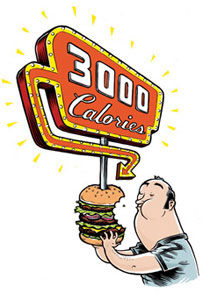public health
Calorie Counting
Is the trend-setting New York City law flawed?
by Kevin Fallon / CAS ’09
 It was apocalyptic news for restaurants: Spurred by reports that Americans consume
one-third of their calories while eating out, New York City was pioneering a law that
would require chain restaurants to post calorie counts next to menu items in a font
and format as prominent as the price. The New York State Restaurant Association was
taking it personally. “The industry is being unfairly targeted,”
complained the association’s New York City Chapters executive vice president
Chuck Hunt. And other groups rallied in their support: “Americans should still
have a right to guilt-free eating,” cried the Center for Consumer Freedom.
But after a two-and-a half-year war and three lawsuits, New York’s
“nutrition police” won and the nation’s first calorie-labeling
law was enacted in July 2008.
It was apocalyptic news for restaurants: Spurred by reports that Americans consume
one-third of their calories while eating out, New York City was pioneering a law that
would require chain restaurants to post calorie counts next to menu items in a font
and format as prominent as the price. The New York State Restaurant Association was
taking it personally. “The industry is being unfairly targeted,”
complained the association’s New York City Chapters executive vice president
Chuck Hunt. And other groups rallied in their support: “Americans should still
have a right to guilt-free eating,” cried the Center for Consumer Freedom.
But after a two-and-a half-year war and three lawsuits, New York’s
“nutrition police” won and the nation’s first calorie-labeling
law was enacted in July 2008.
Little more than a year later, the law is yielding some unappetizing results: The groundbreaking policy may have actually had no effect, at least in the low-income areas surveyed so far. A recent study by NYU researchers suggests that the new labels barely influence food choice, while another study found that they might even encourage some diners to purchase more calories. This is troubling news, notes Brian Elbel, assistant professor at the NYU School of Medicine, as numerous cities around the country roll out their own copycat laws and Congress weighs the LEAN (Labeling Education and Nutrition) Act, a federal bill that would apply menu labeling nationally. “[The legislation] is sweeping across the nation,” Elbel warns. “We really need to understand the extent to which it’s working before we know if it’s a good thing for other cities to do.”
Elbel and a team of researchers polled fast food patrons in low-income areas of New York City and Newark, New Jersey (where there is no labeling policy), both before the law took effect and again a month after. Stationed outside four major food chains, the team collected customers’ receipts and questioned them about their dining choices. Barely 10 percent of those polled noticed any calorie labels in the restaurants before the law, but after July’s enactment that number surged to just over half, which means the labels did raise awareness. What’s concerning, however, is that of the 54 percent of respondents who said they saw the calorie labels, only about a quarter said it mattered to them. Worse, a study conducted by the University of Minnesota revealed that some men actually purchase more calories when menus are labeled. The Big Money, an economic off-shoot of Slate, recently ran “The Big Max,” a chart that broke down fast food favorites by calories per dollar, heralding Pizza Hut’s Meat Lover’s Personal Pan Pizza as the best poverty payoff.
Of course, fighting obesity—not poverty—was the motivation for the law. In 2007, the New York State Public Health Association reported that almost 60 percent of New Yorkers, as well as nearly half of the city’s elementary school children, are overweight or obese, which costs the state and businesses $6 billion a year. “Behind the policy was the assumption that if you had more information, you would make better choices,” says Beth C. Weitzman, associate dean for academic affairs and professor of health and public policy at the Steinhardt School of Culture, Education, and Human Development. “But there are very smart, aware people who know tons about food who are obese.”
So if information is not the cure, what is? Tod Mijanovich, a research assistant professor at the Robert F. Wagner Graduate School of Public Service, wonders whether taxing fat or sugar would work, while Weitzman suggests the “traffic light” system that Britain uses—where a red light warns that food is high in sodium—to blatantly signal unhealthy as opposed to high-calorie foods. But there is also evidence that who you eat with influences what you consume. In a recent study, Weitzman and Mijanovich found that, at least among adolescent girls, peer groups affect eating habits. Others are testing incentive-based approaches. In 2005, for example, Freedom One Financial Group offered a free four-day cruise to Jamaica for employees who met certain weight-loss goals.
Historically, public health policy has helped curb harmful behaviors, such as smoking and drunk driving. “Nobody would’ve believed that you wouldn’t be able to smoke in your office 30 years ago,” Weitzman says. “That would’ve been absolutely fascistic.” Calorie labeling may be a first step then: Elbel’s survey did show that it helps people better estimate the calories they consume. “This may slowly raise awareness,” Mijanovich agrees. “It’s taken 20 years for us to get this fat from supersize-me meals. Maybe it will take another 20 to reverse.”
illustration by Lars Leetaru







